Abstract
One of the most important requirements for a well-designed buckling restrained brace (BRB) under severe earthquake loading is to ensure its stability until the brace achieves sufficient elasto-plastic deformation. This study presents the finite element analysis results of the proposed buckling restrained brace with a longitudinally profiled steel core (LPBRB). The objective of the analyses is to conduct a performance evaluation of the proposed LPBRBs, and to perform a parameter study with different clearance, width:thickness ratio, mortar strength, and friction coefficient for investigating the local buckling behavior of the LPBRBs. Numerical analyses results demonstrate that the LPBRBs exhibited good ductile performance and stable hysteretic behavior. The local buckling failure can be predicted by the demand:capacity ratio formula. The friction coefficient has little influence on the hysteretic behavior of LPBRBs. The local stability can be improved by adopting the mortar with higher compression strength or the LP core with lower width:thickness ratio. The proposed LPBRBs have a similar hysteretic response to the conventional BRBs.
1. Introduction
Buckling-restrained braces (BRBs) have been widely used as either energy dissipation devices or lateral resistant systems in structure engineering and bridge engineering located in seismic-prone areas. The main characteristics of BRBs are the stable hysteretic performance under both tension and compression without buckling, better energy dissipation capacity, and higher displacement ductility. The traditional BRB mainly consists of two components. One is the axial-type energy dissipation core with transition and connection parts at both ends. The other is the restraining member, which is used to prevent the lateral buckling of the inner core under compression. A debonding layer between the inner core and the restraining member is used to eliminate the interface friction and ensure the core expansion caused by Poisson’s effect.
Numerous researchers have conducted experiments on conventional BRBs to meet different seismic requirements [1,2,3,4]. The mechanism behavior of a disassembled dual-core self-centering BRB was experimentally and numerically investigated through a series of full-scale frame tests by Chou et al. [1]. Two full-scale BRB-RCF sub-assemblages with different connection details were conducted by Tsai et al. [2] to study the seismic performance of the proposed connections, and subsequently detailed finite numerical analyses well validated the test results. A novel fishbone shaped BRB with high ductility was proposed and experimentally and numerically investigated by Jia et al. [3]. To perform a quick damage evaluation of the BRB after earthquake, a novel BRB with partial buckling restraint was developed and experimentally studied by Wang et al. [4], of which failure mode was similar the that of the BRB. The key influencing factors on the flexural demand on both of stiffening part and restraining member for the pin-connected BRBs were recently studied by Zhao et al. [5]. The stability design criteria of BRBs considering the stiffening segment of the inner core were proposed by Wu et al. [6,7]. Tremblay et al. [8] validated that the rotation of joint panel would raise the bending moment demand on the restraining member of BRBs by a series of substructure testing.
The finite element method has been one of the most crucial on investigating the seismic performance of BRBs. Aniello et al. [9] conducted a series of numerical analyses on all-steel assembling BRBs, and analyses results showed that the clearance magnitude would affect the intensities of thrust forces and frictions between the core and the restraining member. To accurately evaluate the hysteretic behaviors of conventional BRBs or BRBFs, Rahnavard et al. [10,11,12,13] proposed a simplified core-spring finite element model, whereas Genna and Gelfi [14] adopted a refined two-dimensional finite element model. Both simplified brace finite element models can well simulate the cyclic responses of experimental specimens.
Numerous researches on the local buckling condition of the outer restraining member and the stability design methods to prevent the local bulging failure of tube were reported [15,16,17,18]. Takeuchi et al. [15,16] employed the Euler theory to evaluate the buckling wavelength of the steel core, then the contact force between the core and the restraining member can be determined, whereas the yield line theory and virtual work principle were used by Lin et al. [17,18]. Researches [19,20] show that the severe local buckling of the inner core has significant adverse effect on the low-cycle fatigue behavior of BRBs due to the strain concentration. Thus, a novel modular energy dissipater with even strain distribution along the core is developed by Wang et al. [21].
The longitudinally profiled (LP) steel plate refers to that whose thickness changes continuously along its rolling direction [22]. One of the advantages of using LP steel plate is that the total weight of steel can be reduced. On the other hand, no welds is required at the connections between two steel plates with different thicknesses, which can eliminate the stress concentration at the joints [23,24]. Therefore, the LP steel plate has been widely employed for bridge engineering [25,26]. However, the merits of LP steel plate mentioned above have not been employed for structural vibration control, and few researches were conducted on the hysteretic behavior of BRBs manufactured with the LP steel plate. A novel BRB using the LP steel plate as the inner core called LPBRB was proposed and experimentally tested by Li [27], which exhibited agreeable seismic performance. In this paper, a series of subsequent numerical analyses were conducted to investigate the buckling behavior of LPBRB based on the existing experimental results. The effects of clearance, friction coefficient, mortar strength, and LP core width:thickness on the local buckling behavior are surveyed. In the last part, a comparison is conducted to evaluate the hysteretic behaviors between LPBRBs and BRBs with constant-thickness core.
2. Concept of LPBRB, Experimental Results and Finite Element Model
2.1. Concept of LPBRB
As shown in Figure 1, a LP steel plate without the welded stiffening ribs is chosen as the inner core of LPBRB to dissipate the seismic energy. The LP steel core consists of the yielding segment, LP segment and stiffening segment. The restraining member is composed of a square steel tube filled with the mortar, and the cover plate welded on both ends of the tube is used to enhance the integrity and stability of the restraining member. A rubber sheet is attached on the surface of the LP core to decrease the interface friction and ensure the section expansion caused by Poisson’s effect. The end plate welded on both ends of the LP core is employed to transfer the axial load to the inner core.
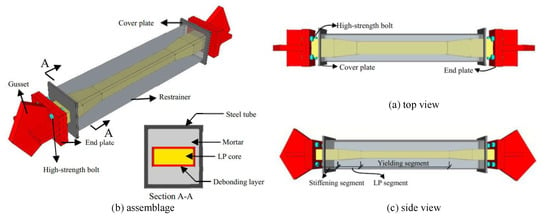
Figure 1.
LPBRB configuration.
2.2. LPBRB Experimental Result
A full-scale LPBRB specimen was tested by Li [27]. As shown in Figure 2, an unribbed LP steel plate was chosen as the steel core for specimen LPBRB1, and its width was enlarged from the LP segment to the end of the core. The LP steel core was locally broadened in the center as a stopper to prevent the restraining member from slipping off the core. An unbonding layer consisted of the rubber plate was attached on the surface of LP steel core to reduce the interface friction between the restraining member and the core. The LPBRB specimen exhibited good hysteretic behavior and suffered fatigue fracturing at the end of test. During the test, a great out-of-plane deformation was observed at the fatigue cycles with 2.5% axial strain (Figure 3), and a slight local bulging of the steel tube was observed after the test (Figure 4).

Figure 2.
LPBRB specimen’s dimensions.
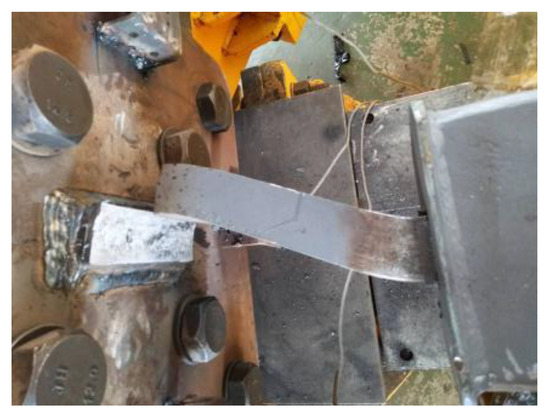
Figure 3.
Out-of-plane deflection of the stiffening part.
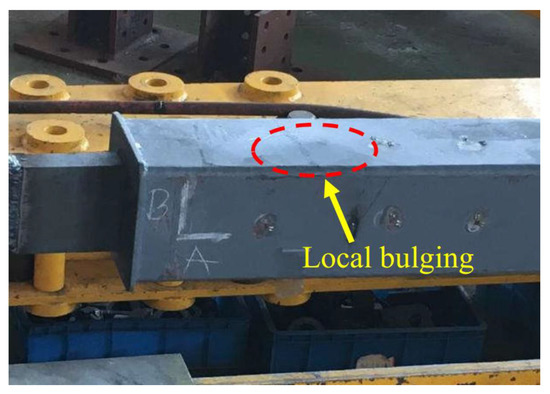
Figure 4.
Local bulging of the outer tube.
2.3. LPBRB Model Description
Finite element analyses were performed on LPBRB models with the software ABAQUS [28]. Finite element models of BRBs are nominated in the form of iCjRkFmMl in which indices i, j, k, m, and l denote the BRB type (LP, SC, and C represent the LPBRBs, conventional constant-thickness-core BRBs with and without stiffening ribs), clearance between the core and the restraining member (C), core width-to-thickness ratio (R), friction coefficient (F), and mortar compression strength (M). The LPBRB numerical models’ geometries and specifications are summarized in Table 1.

Table 1.
The LPBRB numerical models’ geometries and specifications.
Eleven LPBRB specimens with hinged ends were considered in this numerical study, which means only the longitudinal direction degree and rotational degree around the weak axis at both ends of the core were not constrained. All the models consisted of a LP core plate of 4000 mm2 cross-sectional area with different details, and a square steel tube with dimensions of 220 × 220 × 6 mm was adopted. The total length of the BRBs was assumed to be 3200 mm. LP steel core and mortar elements of LPBRBs were modeled using eight-node brick solid elements with the reduced-integration technique (C3D8R), and the four-node shell elements with the reduced-integration technique (S4R) was used for the outer steel tube. The surface-to-surface contact property was assumed to be hard contact for the normal behavior, and tangential coulomb frictional behavior with a penalty friction coefficient of 0.3 was assumed between the LP core and the mortar elements [29]. For normal behavior, the contact model allowed the LP core to be separated from the mortar element, resulting in the higher buckling mode of the core plate. The contact stiffness value with a stiffness scale factor of 1.0 was set by default, and zero clearance was used, at which contact pressure was zero. The mortar was connected with the outer steel tube using the tie constraint. The full Newton-Raphson method was used to solve the nonlinear equations during the analysis. In order to accelerate the convergence, an automatic stabilization factor with a damping coefficient of 4.0 × 10−4 was set. Figure 5 shows the assembly diagram of the LPBRB finite element specimen.
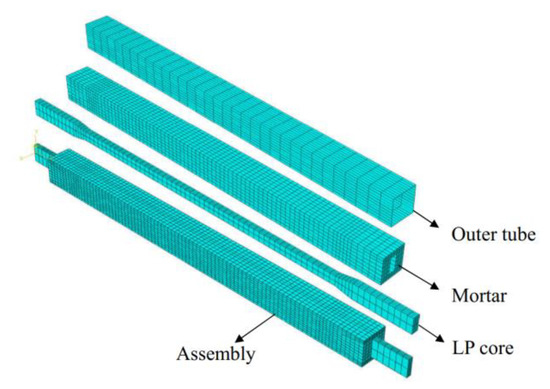
Figure 5.
Finite element model of LPBRB specimen.
The ‘Concrete Damaged Plasticity’ material model prescribed in ABAQUS was used for the mortar filled with the outer tube. According to the mortar cube test results as presented in [27], the Young’s modulus of 30 MPa, Poisson’s ratio of 0.2, and maximum compressive strength of 40 MPa were adopted for the mortar, respectively. The LP steel core and the outer steel tube components were made of steel with a yield stress of fy = 290 MPa. A Young modulus of 205 GPa and a Poisson ratio of 0.3 were assumed for the LP core plate and the outer tube components. A nonlinear combined isotropic-kinematic strain hardening property with multiple backstresses was considered in the nonelastic material property to account for an accurate cyclic hardening behavior. The calibrated parameters for the finite element analyses are listed in Table 2 and Table 3, based on the experimental results. Note: Q∞ is the maximum change in the size of the yield surface, b is the cyclic hardening parameter, Ci and γi denote the kinematic hardening parameters. ψ is dilation angle, ϵ is flow potential eccentricity, σb0/σc0 is the ratio of initial equibiaxial compressive yield stress to initial uniaxial compressive yield stress, K is the ratio of the second stress invariant on the tensile meridian to that on the compressive meridian, and μ is viscosity parameter. Figure 6 represents the calibrated cyclic response based on the combined hardening model.

Table 2.
Parameters of the combined hardening model.

Table 3.
Parameters of concrete damaged plasticity model.
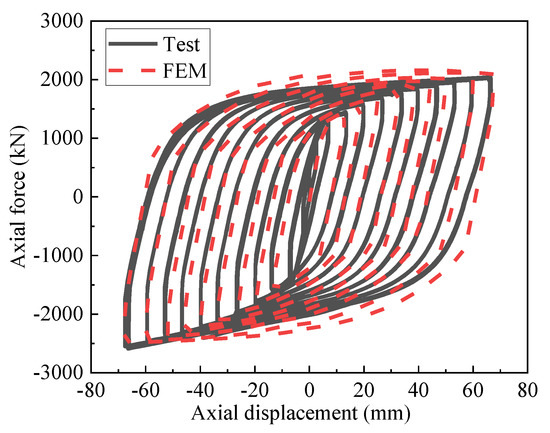
Figure 6.
Calibrated hysteretic response of the steel material.
Referring to the cyclic quasi-static protocol suggested by AISC seismic provision [30], the axial displacements were enforced at both ends of LP core, following the loading protocol which was divided into two stages as shown in Figure 7. Stage I was standard cycles with an increment of 0.5% core strain (axial deformation of the core divided by the yielding segment length) in each of the two cycles to 3.5%. Then, the stage II with 3.0% core strain continued until failure.
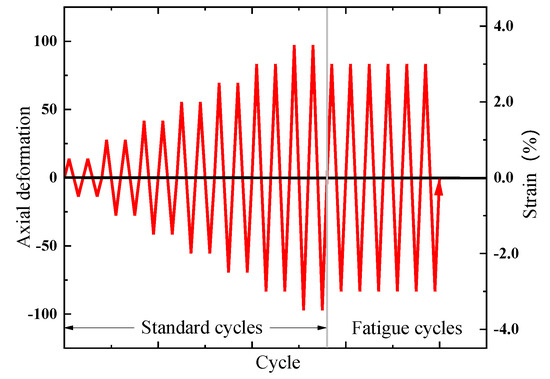
Figure 7.
Loading protocol.
3. Results and Discussions
3.1. Effect of Clearance between the LP Core and the Restraining Member
To ensure the stability of LPBRB and achieve a plump hysteretic response, an appropriate gap between the LP core and the restraining member is required to allow for the lateral expansion of the LP core. Three numerical models with different amounts of gap were conducted to investigate the effect of clearance on local buckling behavior of LPBRBs. Based on an assumption of plastic Poisson’s ratio of 0.5 for LP core and a maximum anticipated core axial strain of 3.5%, a minimum clearance can be estimated by:
where wc denotes the LP core width. By adopting the procedure above for the models with a LP core dimensions of 100 × 40 mm2 yielded a minimum clearance of 2 mm. The gap of the other two models were 3 and 5 mm, respectively, and the remaining parameters of each LPBRB were the same. The hysteretic response curves are represented in Figure 8. Local buckling of model LPC2R25F1M40 occurred at the first circle of 3.5% axial strain, and the other models buckled at the second circle and first circle of 2.5% axial stain, respectively. According to [18], the local buckling failure can be evaluated by the demand-to-capacity ratio (DCR). The DCR is illustrated as follows:
where fp,max and fs denote the maximum bulging force and capacity of outer tube in resisting the outward force, respectively. The maximum contact force can be evaluated by
where Pmax is the maximum compression strength of the BRBs until local buckling failure, and C is the clearance between the LP core and the restraining member. lw denotes the high mode buckling wavelength, which can be calculated with
where tp is the core thickness, respectively. The capacity of outer tube to resist the bulging force can be predicted as follows:
where ws and weff are the width of steel tube and the distribution length of contact force acting on the tube, respectively. Mps is the plastic moment capacity of steel tube, which can be estimated as follows:
where ts and Fys are the thickness and the yield strength of the steel casing.
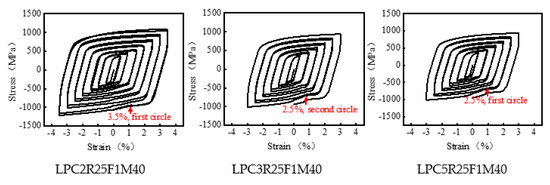
Figure 8.
Hysteretic response curves of the proposed LPBRBs.
All the parameters of three models are the same but for the clearance, thus the difference among three models mainly depends on the contact force demand of the LP core. Obviously, the larger the gap, the greater the contact force between the LP core and the restraining member, under the same axial compressive force. When the contact force demand exceeds the capacity of the outer tube in resisting the local bulging with the increasing axial load, local instability of the LPBRBs will occur. As seen in Table 4, the DCRs of the LPBRBs with local instability are all greater than 1.0, which means the local buckling failure can be well predicted by the Equation (2).

Table 4.
The LPBRB numerical models’ seismic performance indices.
3.2. Effect of Friction Coefficient
As discussed above, a suitable clearance may meet the lateral expansion and axial slip of the core. However, an undesirable friction will be caused, when the inner core buckles and contacts with the restraining member. This is the major reason of the unbalanced response of conventional BRBs, which can be evaluated by the compression strength adjustment factor β. An excessive unbalanced response may result in an additional shear in the mid-span of the beam with an inverted-V-braced BRB, and lead to a premature global or local instability of the BRBs. Therefore, the compression strength adjustment factor β of BRBs is suggested to be less than 1.30 as specified in the AISC seismic provision [30].
Six finite element models were conducted to investigate the effect of friction on hysteretic behavior of LPBRBs. Two friction coefficients of 0.1 and 0.3 were adopted to provide two different contact condition between the LP core and the restraining member. The coefficient of 0.1 represents a greasy interface between the restraining member and the rubber plate attached on the core, and 0.3 denotes a rough contact situation when the rubber layer is rubbed off. The hysteretic response curves are represented in Figure 9. According to Table 4, under different width:thickness ratios, the compression strength adjustment factors of the models with 0.3 friction coefficient are slightly larger than those with the friction coefficient of 0.1. The hysteretic response curves of each pair of models with different coefficients are almost same, and the same applies to the compression strengths corresponding to local buckling. This means that the friction coefficient has little influence on the hysteretic behavior of LPBRBs. The unbalanced response indices β of six models with different width:thickness ratios are all less than 1.10, thus well satisfying the requirement suggested in the AISC seismic provision [30].
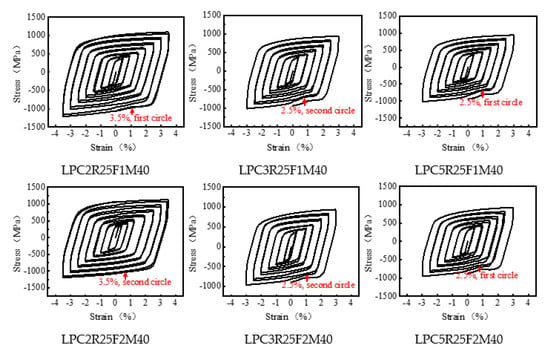
Figure 9.
Hysteretic response curves of the proposed LPBRBs.
3.3. Effect of Mortar Strength in Preventing Local Buckling Failure
The local buckling failure depends on the contact force demand acting on the restraining member and the capacity of the outer tube to resist local bulging. There is no doubt that it is a conservative strategy to ignore the contribution of the mortar filled in the steel tube when evaluating the capacity of the restraining member in resisting outward force. The design clearance is generally adopted to estimate the outward force demand. However, the mortar may be crushed and lose the bearing capacity due to insufficient compressive strength. More severely, the gap between the LP core and the restraining member will be enlarged by the crushed mortar, which in turn will lead to an increase of the contact force demand. Thus, a premature local buckling failure of LPBRBs will result. Furthermore, the magnified clearance will increase the bending strain amplitude of the inner LP core under compression, then the fatigue performance of the LPBRBs will be reduced.
Three numerical models with three different mortar compressive strengths of 95 MPa, 40 MPa and 20 MPa were adopted to study the abovementioned issue, and the corresponding stress-strain curves are represented in Figure 10. It can be drawn from Figure 10 that LPC3R25F1M95 always has a stable hysteretic behavior until the axial core strain of 3.5% is achieved. The local buckling occurred at the 2.5% and 2.0% axial strain for the models LPC3R25F1M40 and LPC3R25F1M20, respectively. The corresponding equivalent plastic strain of mortar is shown in Figure 11. It can be drawn from Figure 11 that the damage level of the mortar from low to high is LPC3R25F1M95, LPC3R25F1M40, and LPC3R25F1M20, which is consistent with the previous analyses.

Figure 10.
Hysteretic response curves of the proposed LPBRBs.
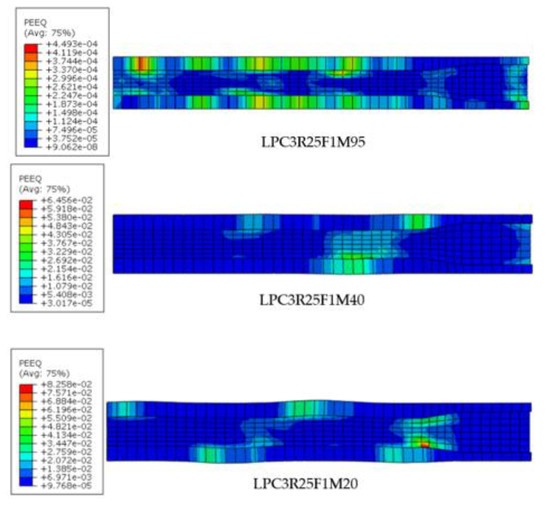
Figure 11.
Damage level of the mortar at axial core strain of 2% under compression.
3.4. Effect of Width-to-Thickness Ratio of LP Core
Two numerical models with core width:thickness ratio of 2.5 and 6.4 were adopted to study the abovementioned issue, and the corresponding hysteretic curves are shown in Figure 12. As seen in Figure 12, the local instability firstly occurred in the model with the width:thickness ratio of 6.4, followed by the model LPC2R25F1M40 at the axial core strain of 3.5%. The reason is that the out-of-plane stiffness of the LP core of model LPC2R25F1M40 is slightly greater than that of model LPC2R64F1M40, which results in a lower stability of the LP core of the latter. Thus, the LPBRB with greater width:thickness ratio has worse local stability behavior. On this basis, it is recommended to adopt the LP steel plate with lower width:thickness ratio in the design where possible.
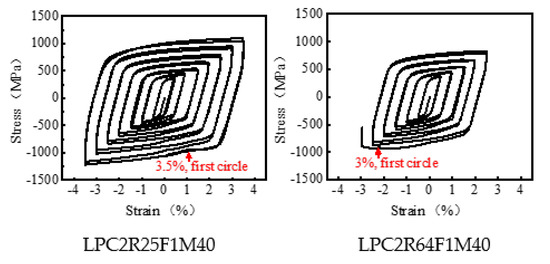
Figure 12.
Hysteretic response curves of the proposed LPBRBs.
3.5. Comparison of LPBRBs and BRBs with the Constant-Thickness Steel Core
Welded stiffeners are usually required to improve the out-of-plane stability for the conventional BRBs with the constant thickness core. However, the manufacture cost of BRBs will also go up, and a premature fatigue fracture around the end of welded ribs may be caused due to welding residual stress. Three models with different core configurations were used to compare the hysteretic behavior from the LPBRBs and the BRBs with the constant thickness core. As seen in Table 1, SCBRB denotes the conventional BRBs with the welded stiffening ribs, and no ribs are employed on the constant thickness core for CBRB. The hysteretic loops of three models are represented in Figure 13. It can be drawn from Figure 13 that local buckling occurred at 1.5% axial strain for model CC2R64F1M40, and the compression strengths of the other models dropped at 3.0% and 3.1% strain, respectively. This indicates the stiffeners can significantly improve the seismic performance of the conventional BRBs.

Figure 13.
Hysteretic response curves of the proposed LPBRBs.
The reason for models CBRB and LPBRB having almost the same hysteretic behavior can be given as two points. On one hand, the LP core can partly raise the out-of-plane stiffness of the core outside the restraining member. On the other hand, the axial force demand of the inner core gradually increases from the center to the end of the core due to the friction. The magnified cross-sectional area of the LP core can reduce the stress level around the end of the core, which is beneficial to improve the seismic performance of LPBRBs.
4. Conclusions
In this study, a series of finite element analyses are conducted to investigate the hysteretic behavior of the proposed LPBRBs based on the existing experimental results. The conclusions can be drawn as follows:
The contact force demand of LPBRBs is positively associated with the clearance between the LP core and the restraining member. The demand:capacity ratio formula can be used to predict the local buckling failure of LPBRBs. The friction coefficient has little influence on the hysteretic behavior of LPBRBs. The compression strength adjustment factor β of all LPBRB models is less than 1.10, thus satisfying the requirement suggested in the AISC seismic provision. The LPBRBs with the lower width:thickness ratio has better local stability, and it is suggested to adopt the LP steel plate with lower width:thickness ratio in design as possible. The crushed mortar infilled with the restraining member can cause a premature local buckling failure of LPBRBs, the seismic performance of which can be improved through adopting the higher strength mortar. The proposed LPBRBs demonstrate similarly stable hysteretic behavior with the conventional BRBs with the constant thickness core. In the future, attention should be paid to the effect of framing systems with gusset connections on the mechanical behavior of LPBRBs. The global and local stability design methods on LPBRBs should be another two key issues.
Author Contributions
Conceptualization and methodology, S.X. and Y.D.; software and validation, W.L. and Y.L.; writing, J.L. All authors have read and agreed to the published version of the manuscript.
Funding
This research was funded by National Natural Science Foundation of China, grant number 51908108 and Hebei Key Laboratory of Earthquake Disaster Prevention and Risk Assessment, grant number FZ213205.
Data Availability Statement
Not applicable.
Acknowledgments
The authors would like to thank the Editorial Board and two anonymous reviewers for their constructive feedback that improved the final version of the paper.
Conflicts of Interest
The authors declare that we do not have any commercial or associative interest that represents a conflict of interest in connection with the work submitted.
References
- Chou, C.C.; Chung, P.T. Development of cross-anchored dual-core self-centering braces for seismic resistance. J. Constr. Steel Res. 2014, 101, 19–32. [Google Scholar] [CrossRef]
- Tsai, C.Y.; Tsai, K.C.; Chen, L.W.; Wu, A.C. Seismic performance analysis of BRBs and gussets in a full-scale 2-story BRB-RCF specimen. Earthq. Eng. Struct. Dyn. 2018, 47, 2366–2389. [Google Scholar] [CrossRef]
- Jia, L.J.; Ge, H.B.; Xiang, P.; Liu, Y. Seismic performance of fish-bone shaped buckling-restrained braces with controlled damage process. Eng. Struct. 2018, 169, 141–153. [Google Scholar] [CrossRef]
- Wang, C.L.; Chen, Q.; Zeng, B.; Meng, S.P. A novel brace with partial buckling restraint: An experimental and numerical investigation. Eng. Struct. 2017, 150, 190–202. [Google Scholar] [CrossRef]
- Zhao, J.X.; Wu, B.; Ou, J.P. A practical and unified global stability design method of buckling-restrained braces: Discussion on pinned connections. J. Constr. Steel Res. 2014, 95, 106–115. [Google Scholar] [CrossRef]
- Lu, J.K.; Wu, B.; Mei, Y. Buckling mechanism of steel core and global stability design method for fixed-end buckling-restrained braces. Eng. Struct. 2018, 174, 447–461. [Google Scholar] [CrossRef]
- Wu, B.; Lu, J.K.; Mei, Y.; Zhang, J. Buckling mechanism and global stability design method of buckling-restrained braces. J. Constr. Steel Res. 2017, 138, 473–487. [Google Scholar] [CrossRef]
- Tremblay, R.; Bolduc, P.; Neville, R.; Devall, R. Seismic Testing and Performance of Buckling-Restrained Bracing Systems. Can. J. Civ. Eng. 2006, 33, 183–198. [Google Scholar] [CrossRef]
- Aniello, M.; Corte, G.; Landolfo, R. Finite element modelling and analysis of “all-steel” dismountable buckling-restrained braces. Open Constr. Build. Technol. J. 2014, 8 (Suppl. 1: M4), 216–226. [Google Scholar]
- Rahnavard, R.; Naghavi, M.; Aboudi, M.; Suleiman, M. Investigating modeling approaches of buckling-restrained braces under cyclic loads. Case Stud. Constr. Mater. 2018, 8, 476–488. [Google Scholar] [CrossRef]
- Naghavi, M.; Rahnavard, R.; Thomas, R.J.; Malekinejad, M. Numerical evaluation of the hysteretic behavior of concentrically braced frames and buckling restrained brace frame systems. J. Build. Eng. 2019, 22, 415–428. [Google Scholar] [CrossRef]
- Rahnavard, R.; Rebelo, C.; Craveiro, H.; Napolitano, R. Numerical investigation of the cyclic performance of reinforced concrete frames equipped with a combination of a rubber core and a U-shaped metallic damper. Eng. Struct. 2020, 225, 111307. [Google Scholar] [CrossRef]
- Rahnavard, R.; Rebelo, C.; Craveiro, H.; Napolitano, R. Understanding the cyclic performance of composite steel-concrete connections on steel bridges. Eng. Struct. 2020, 224, 111213. [Google Scholar] [CrossRef]
- Genna, F.; Gelfi, P. Analysis of the lateral thrust in bolted steel buckling-restrained braces. Part 1: Experimental and numerical results. J. Struct. Eng. 2012, 138, 1231–1243. [Google Scholar] [CrossRef]
- Takeuchi, T.; Hajjar, J.F.; Matsui, R. Local buckling restraint condition for core plates in buckling restrained braces. J. Constr. Steel Res. 2010, 66, 139–149. [Google Scholar] [CrossRef]
- Takeuchi, T.; Hajjar, J.F.; Matsui, R.; Nishimoto, K.; Alike, I.D. Effect of local buckling core plate restraint in buckling restrained braces. Eng. Struct. 2012, 44, 304–311. [Google Scholar] [CrossRef]
- Lin, P.C.; Tsai, K.C.; Chang, C.A.; Hsiao, Y.Y.; Wu, A.C. Seismic design and testing of buckling-restrained braces with a thin profile. Earthq. Eng. Struct. Dyn. 2016, 45, 339–358. [Google Scholar] [CrossRef]
- Lin, P.C.; Tsai, K.C.; Wang, K.J. Seismic design and hybrid tests of a full-scale three-story buckling-restrained braced frame using welded end connections and thin profile. Earthq. Eng. Struct. Dyn. 2012, 41, 1001–1020. [Google Scholar] [CrossRef]
- Wang, C.L.; Usami, T.; Funayama, J. Improving low-cycle fatigue performance of high-performance buckling-restrained braces by toe-finished method. Earthq. Eng. 2012, 16, 1248–1268. [Google Scholar] [CrossRef]
- Matsui, R.; Takeuchi, T. Cumulative deformation capacity of buckling restrained braces taking local buckling of core plates into account. In Proceedings of the 15th World Conference on Earthquake Engineering, Lisbon, Portugal, 24–28 September 2012. [Google Scholar]
- Wang, C.L.; Zhao, J.; Gao, Y.; Meng, S.P. Experimental investigation of modular buckling-restrained energy dissipaters with detachable features. J. Constr. Steel Res. 2020, 172, 106191. [Google Scholar] [CrossRef]
- Liu, X.H. Prospects for variable gauge rolling: Technology, theory and application. J. Iron Steel Res. Int. 2011, 18, 1–7. [Google Scholar] [CrossRef]
- Fukumoto, Y.; Takaku, T.; Aoki, T.; Susantha, K. Innovative Use of Profiled Steel Plates for Seismic Structural Performance. Adv. Struct. Eng. 2005, 8, 247–257. [Google Scholar] [CrossRef]
- Lu, J.K. Stability Design Methods and Tests of Buckling-Restrained Braces and Gusset Plates. Ph.D. Thesis, Harbin Institute of Technology, Harbin, China, 2017. (In Chinese). [Google Scholar]
- Brozzetti, J. Design development of steel-concrete bridges in France. J. Constr. Steel Res. 2000, 55, 229–243. [Google Scholar] [CrossRef]
- Takaku, T.; Fukumoto, Y.; Aoki, T. Seismic design of bridge piers with stiffened square box columns with thickness tapered plates. In Proceedings of the 13th World Conference on Earthquake Engineering, Vancouver, Canada, 1–6 August 2004; p. 3224. [Google Scholar]
- Li, Y.Y. Investigation on the Design Method and the Seismic Performance for the BRBs with Longitudinally Profiled Steel Plate as Inner-Core. Master’s Thesis, Harbin Institute of Technology, Harbin, China, 2017. (In Chinese). [Google Scholar]
- ABAQUS/Standard, Version 6.20; ABAQUS Inc.: Pawtucket, RI, USA, 2020.
- Hoveidae, N.; Rafezy, B. Local Buckling Behavior of Core Plate in All-Steel Buckling Restrained Braces. Int. J. Steel Struct. 2015, 15, 249–260. [Google Scholar] [CrossRef]
- American Institute of Steel Construction. AISC 341-10: Seismic Provisions for Structural Steel Buildings; American Institute of Steel Construction: Chicago, IL, USA, 2010. [Google Scholar]
Publisher’s Note: MDPI stays neutral with regard to jurisdictional claims in published maps and institutional affiliations. |
© 2021 by the authors. Licensee MDPI, Basel, Switzerland. This article is an open access article distributed under the terms and conditions of the Creative Commons Attribution (CC BY) license (https://creativecommons.org/licenses/by/4.0/).